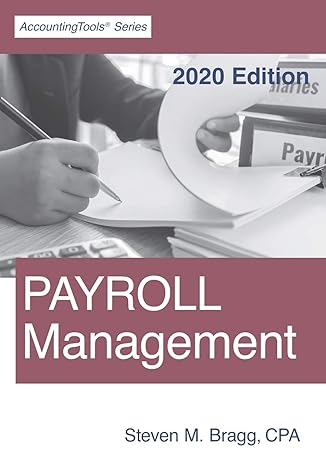Answered step by step
Verified Expert Solution
Question
1 Approved Answer
Record your cash (or check) paid-out transactions. You are the owner of a store. You purchase items worth $7,800 on account from your main supplier.
Record your cash (or check) paid-out transactions. You are the owner of a store. You purchase items worth $7,800 on account from your main supplier. Most of the purchase is inventory for resale, but also includes office supplies worth $100. Make the following entry in your Purchases Journal: Debit Credit Purchases $7,700 Office supplies expense $100 Accounts payable $7,800 Next month, after receiving a statement from your supplier, you write a check to settle your account. Make the following entry in your Purchases Journal: Debit Credit Accounts payable $7,800 Cash $7,800 Assume that your business is a retail store that sells merchandise for resale. Here is an example of a few entries in a Purchases Journal. The following transactions occurred: (Note: All dollar amounts have been rounded off to the nearest dollar.) On February 2, you paid an electricity bill of $177. Also on February 2, you bought merchandise inventory on account from Ash Wholesale at a cost of $9,500. On February 5, you spent $82 at Atkins Service Station to fill up your delivery vehicles with gas. You charged it all to the account you maintain with Atkins. On February 8, you write a check for $9,500 in payment of the bill you receive from Ash Wholesale. On February 10, you write a check for $82 to Atkins Service Station to settle your account there. Upon completion of this journal page, you should foot all the seven amount columns. Guidelines: Check that all entries were recorded correctly, as you are using a double-entry accounting system. Check to see if the sum of the debits equals the sum of the credits. Total debits: 0 + 9,582 + 9,500 + 82 + 177 = 19,341. Total credits: 9,759 + 9,582 = 19,341. If the sum of the debit columns does not equal the sum of the credit columns, identify where the problem has occurred. You may have entered one of the amounts in the wrong column. You may have added the totals incorrectly. It is usually easy to pinpoint the error because the debits should equal the credits for each transaction. Your purchases journal may have many more columns than this sample, because you probably will have more expense classifications
Step by Step Solution
There are 3 Steps involved in it
Step: 1

Get Instant Access to Expert-Tailored Solutions
See step-by-step solutions with expert insights and AI powered tools for academic success
Step: 2

Step: 3

Ace Your Homework with AI
Get the answers you need in no time with our AI-driven, step-by-step assistance
Get Started


